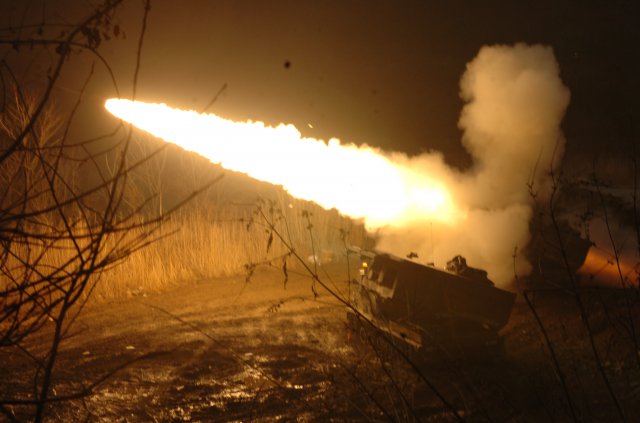
Army Multiple Launch Rocket System
WASHINGTON: Money is the sincerest form of flattery. When Deputy Secretary of Defense Bob Work visited the Association of the US Army conference here today, he not only delivered a ringing endorsement of the Army’s new Multi-Domain Battle concept: He also offered to help fund it.
Army leaders lament their modernization budget is $36 to $40 billion below the Navy’s and the Air Force’s, so Work’s help would be especially welcome. But the deputy was not explicit about how much money might come or when. As architect of the Pentagon’s Third Offset Strategy for modernization, Work wants the Army to firm up the nascent concept first, and it’s unclear they can do that in time for the 2018 budget proposal now grinding through the Pentagon bureaucracy. There’s plenty of time for 2019, but that budget will be built by the next administration, when Work may well be gone — and if Trump wins, absolutely every bet is off.

Robert Work
“Multi-domain battle is where we really need to go,” Work enthused this morning at AUSA. Beside him sat Air Force Chief of Staff David Goldfein, Marine Corps Commandant Robert Neller, Navy undersecretary Janine Davidson, and Pacific Command chief Adm. Harry Harris. All these non-Army luminaries had gathered to discuss the concept, which calls for the services to step outside their traditional jurisdictions — by the Army fielding high-powered jammers and land-based anti-ship weapons, for instance — and work together against advanced adversaries like Russia and China.
“I could not agree more with the chief: The character of war is changing,” Work said, quoting Army Chief of Staff Mark Milley. In particular, Work said, Russia and its Ukrainian separatist proxies have shown a multi-domain capability of their own. Ground-based anti-aircraft missiles clear the sky of Ukrainian government planes. Electronic warfare systems detect and jam Ukrainian communications. Drones scout out the source of Ukrainian transmissions and target them for devastating artillery barrages.
In the late Cold War, Work said, the military maxim was, if you could see it, you could hit it, and if you could hit it, you could kill it. Today, “the new adage is: ‘if you emit, you die.’”
“I’m proud to say the Army has really been getting after it,” Work said. In the 2017 budget process, as he told me in an interview in February, he asked the Army to do for the new era of warfare what the Army-Air Force doctrine of AirLand Battle did for Soviet-style massed armor in the 1980s and the 1991 Gulf War. As Work put it today, “I challenged the Army at that time, would you please start thinking about AirLand Battle 2.0?”
“Thankfully, Gen. [David] Perkins and [Lt.] Gen. [H.R.] McMaster didn’t listen to me,” Work said, referring to the commander and deputy of the Training & Doctrine Command (TRADOC). They looked beyond AirLand Battle to envision war in what Gen. Perkins called Multi-Domain Battle.”
Multi-Domain Battle seeks to counter Russian- and Chinese-style layered defenses of long-range missiles backed by ships, submarines, and aircraft, known as Anti-Access, Area Denial (A2/AD). Past concepts have called for laboriously “rolling back” am A2/AD network “so we can get the rest of the joint force in,” Work said.
Multi-domain battle and parallel concepts in other services don’t wait for rollback. Instead, they seek to push ahead through weak points in the A2/AD zone — exploiting every avenue in the air, on the sea, on the land, and in cyberspace. Like water undermining a cliff, the idea is to pour combat power through every gap you can find and force them wider until the entire network shatters.
With Anti-Access/Area Denial, “adversaries think they can keep us out. I’m here to tell you they’re absolutely wrong,” said Work. “We will quite frankly pound the snot out of them — from range and in the close fight.”
Army eyes TBI monitoring, wearable tech for soldiers in high-risk billets
“We are also looking at what additional personal protective equipment we can provide to our folks, especially instructors and others who are routinely exposed to blast pressure,” said Army Secretary Christine Wormuth.


























